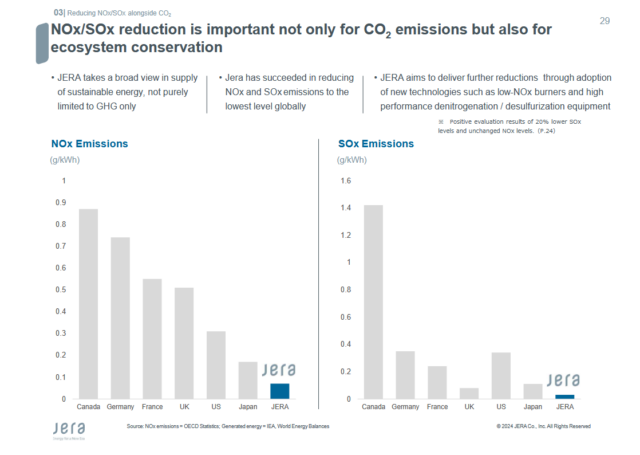JERA concludes successful co-firing trial at Hekinan
By Julian Atchison on July 01, 2024
Stable 1 GW output, reduced emissions

Click to learn more. JERA and IHI have announced the conclusion of a successful, two-month ammonia co-firing trial at Hekinan power station.
JERA and IHI have successfully concluded a large-scale ammonia co-firing trial at the Hekinan power station. Beginning on April 10th of this year, 20% fuel substitution in Unit 4 was achieved, with stable operations at the rated output (1 GW) continuing throughout the trial. JERA indicated that the trial ran until early June, around two months in total. As for pollutant emissions during the trial:
Results were positive, confirming that the level of nitrogen oxides (NOX) generated was no higher than before fuel ammonia substitution (than when firing coal alone), a 20% reduction in sulfur oxides (SOX), and that generation of N2O, which has a strong greenhouse effect, was below the threshold for detection. We also confirmed that operability was comparable to before fuel ammonia substitution (to when firing coal alone).
Emissions from the 20% ammonia co-firing trial at Hekinan, as detailed in JERA’s official press release, 26 June 2024
Based on the results of the trial, JERA will now begin preparations for continuous, commercial operations of 20% ammonia co-firing at Hekinan Unit 4. By March 2025, it aims to “establish…technologies aimed at mainstreaming the use of ammonia as fuel in thermal power generation”.
100% ammonia substitution by the 2040s

Click to expand. JERA reports that its current thermal power generation fleet has the lowest level of NOX and SOX emissions in the world – a standing it aims to maintain even with the switch to ammonia fuel Source: JERA.
As detailed in JERA’s long-term growth strategy, by 2030 it aims to close all supercritical or less coal power plants, and have demonstrated ammonia co-firing is feasible for the remainder (ultra-supercritical power stations). By 2035, a minimum of 50% ammonia co-firing will be achieved for coal power plants, moving to 100% substitution in the 2040s. Combined with an increase in deployed offshore wind power, this takes JERA to zero operational emissions by 2050. The trail results also confirm another long-term aim of JERA’s: to have power generation fleet in the world (in terms of NOX and SOX per kWh generated).